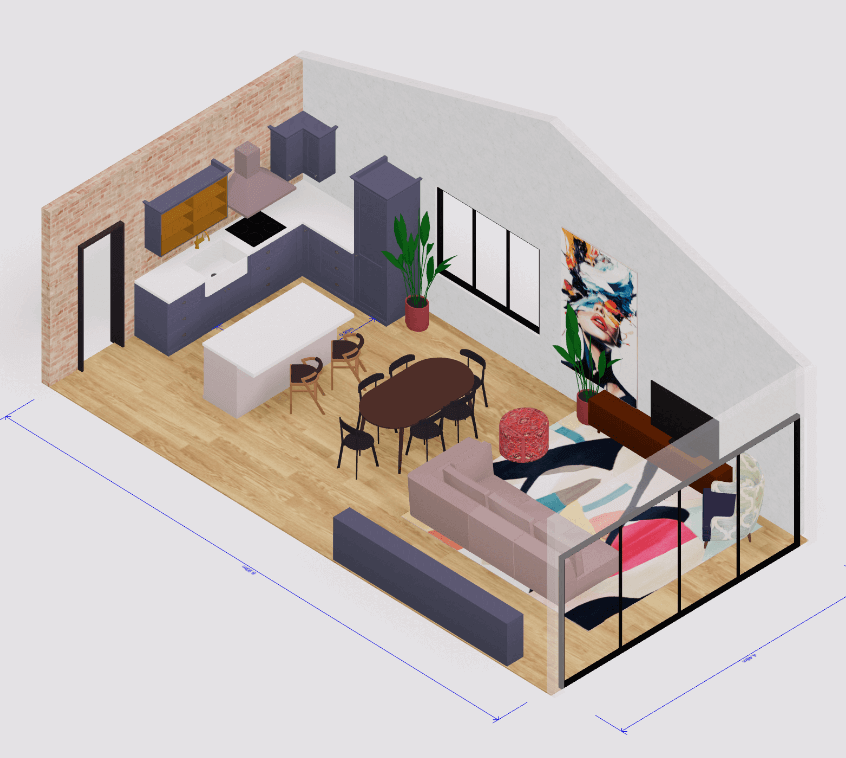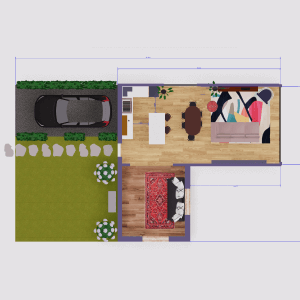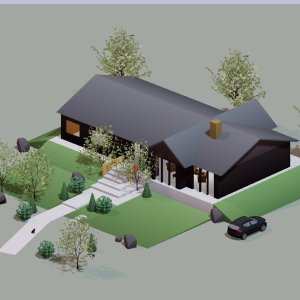3D models streamline communication between clients and contractors. Clients visualize proposed designs accurately, eliminating misunderstandings. Contractors receive clear, detailed instructions, reducing construction errors. Studies show 3D visualization improves client satisfaction by 40% as clients can see and approve designs before construction begins. Projects utilizing 3D models report a 20% decrease in project completion time due to fewer revisions and misunderstandings.
3D models enhance collaboration more effectively than traditional 2D blueprints. Clients understand 3D models easily, whereas 2D blueprints require technical knowledge. Contractors extract precise measurements from 3D models, ensuring accurate material orders. Feedback loops tighten as clients suggest changes directly on 3D representations, leading to real-time updates by designers. Industry benchmarks indicate projects using 3D models save up to 15% on construction costs due to increased efficiency and reduced waste.
In this context, Arcadium 3D emerges as a valuable tool for both non-professionals and for virtual staging professionals. It offers a browser-based, simple solution to create 3D house plans swiftly. This accessibility facilitates communication between all parties involved, ensuring that visions transform into reality with minimal hassle.
Contents:
Benefits of 3D Models in Construction Collaboration
Why are 3D models advantageous for enhancing accuracy in construction projects? They eliminate common errors. Architects share precise dimensions, while engineers adjust structural supports accurately. This process reduces misunderstandings, ensuring teams work from a unified, detailed blueprint.
How do 3D models streamline communication among stakeholders? They provide a visual reference. Clients visualize the end product, and project managers identify potential conflicts. Such visual aids foster clear, effective dialogue, minimizing the need for extensive revisions.
Can 3D models improve project timelines? They certainly expedite project completion. By detecting design conflicts early, teams avoid delays. Material orders become more accurate, preventing surplus or shortages. This efficiency not only accelerates construction phases but also optimizes resource allocation.
3D models offer superior collaboration benefits over traditional 2D blueprints. Stakeholders engage more meaningfully when they can explore a project's spatial aspects. This depth of interaction enhances problem-solving capacities, leading to innovative solutions. In essence, the ability to visualize complex structures in three dimensions before construction starts ensures that everyone involved aligns with the project vision, mitigating risks and fostering a smoother execution.
Effective Communication with 3D Visualizations
Why do 3D visualizations streamline the dialogue between project stakeholders? They offer a clear, interactive representation of the final product. Visual aids like models and renderings help in pinpointing inaccuracies, making it simpler for architects and construction managers to identify and rectify errors. By contrast, 2D drawings or verbal descriptions often lead to misunderstandings, resulting in costly corrections down the line.
How can feedback loops be shortened with 3D visualizations? They enable instant revisions and foster immediate consensus. When clients or builders suggest modifications, changes can be visualized and assessed on the spot. This process eliminates the need for lengthy explanations and back-and-forth exchanges typically encountered with traditional methods. As a consequence, decision-making accelerates, keeping projects on schedule.
What role do 3D visualizations play in mitigating project risks? They reveal potential conflicts and design flaws before physical work begins. Tools like clash detection software examine the digital model for any spatial or technical clashes, such as pipes running through beams, which are often overlooked in 2D drawings. This proactive approach saves money by avoiding construction delays and mitigating safety hazards.
3D visualizations not only enhance communication but also eclipse older techniques in efficiency and clarity. Projects that utilize these advanced models witness fewer misunderstandings among team members, as visual clarity translates to fewer errors and discrepancies. They outshine traditional methods by providing immersive experiences that allow for better spatial understanding, making them indispensable for modern construction projects.
Impact on Project Timelines and Efficiency
How do 3D models influence project timelines? They significantly shorten them. By providing a detailed view of the project from conception to completion, 3D models facilitate rapid decision-making. Architects make designs; engineers analyze structures, ensuring all stakeholders can review and approve plans swiftly, thus streamlining the construction process.
What effects do 3D models have on efficiency? They enhance it. With the ability to detect potential conflicts before construction begins, 3D models save time and resources. Workers execute tasks, managers oversee progress, and clients suggest revisions, all within a unified, error-reduced workflow. This coordination ensures projects advance smoothly without the frequent pauses for clarification and correction that traditional blueprints necessitate.
Can 3D models reduce misunderstandings among project teams? Absolutely. They serve as a common language. Where words fall short, visual representations speak volumes. Carpenters interpret dimensions, electricians understand wiring paths, and plumbers identify pipe locations accurately, minimizing costly and time-consuming errors due to miscommunication.
In assessing the impact on timelines and efficiency, projects utilizing 3D models consistently outperform those relying on traditional methods. Projects reach completion faster, as streamlined communication and error detection accelerate every phase. Efficiency benefits, with teams working cohesively and resources allocated more effectively, underscore the superiority of integrating 3D models into construction planning.
Cost Management and Budget Optimization
Why is cost management crucial when working with contractors and builders? It prevents overspending and ensures resources are allocated efficiently. Effective cost management identifies potential savings by scrutinizing every detail of the project plans. By detecting areas of excess, such as unnecessary material usage or labor, adjustments can be made to reduce expenses without compromising quality. These adjustments lead to significant financial efficiencies.
How do 3D models enhance budget optimization in construction projects? They provide a detailed visualization of the project before physical work begins. This visualization aids in precise material estimations, eliminating the guesswork that often leads to overordering or underordering. 3D models allow for the identification of design conflicts that, if unaddressed, could lead to costly corrections during construction. Resolving such issues in the planning phase reduces unexpected expenditures, streamlining budget allocation.
Can 3D modeling tools influence the communication between clients and builders regarding finances? Absolutely. These tools serve as a common language, simplifying complex concepts into understandable visuals. By presenting cost implications of design choices in real-time, decisions can be made with a clear understanding of their financial impact. This transparency fosters trust, ensuring all parties are aligned with the budgetary constraints and project goals. Misunderstandings are minimized, leading to a smoother project flow with fewer financial surprises.
In the domain of construction, leveraging 3D models for project planning and execution yields superior financial outcomes to traditional methods. Projects embracing these technologies enjoy enhanced accuracy in cost estimations, fostering tighter control over the budget. The early detection of design conflicts minimizes costly mid-construction changes. This approach ensures a more economical allocation of resources, maximizing value for clients and stakeholders.
Streamlining Decision-Making Processes
Why is streamlining decision-making processes critical when working with contractors and builders? Swift decision-making reduces project timelines. Delayed choices often result in prolonged construction periods, increased costs, and heightened frustration among stakeholders. Conversely, rapid consensus accelerates project phases, curtails expenses, and boosts satisfaction across the board.
How do 3D models facilitate better communication among project teams? They offer a visual and interactive representation of ideas. Traditional methods like verbal descriptions or two-dimensional drawings are prone to misinterpretation, but 3D models provide a clear, unified vision. This clarity prevents misunderstandings, ensures that all parties are aligned with the project's objectives, and enables precise execution of plans.
What benefits arise from using 3D models in discussions with contractors and builders? Enhanced collaboration leads to innovative solutions. By examining a project from various angles and in different scenarios, teams can identify potential problems before they materialize. This proactive approach not only saves time and money but also fosters a creative environment where team members can propose improvements and alternatives that might have been overlooked otherwise.
In discussions involving complex projects, 3D models prove to be more efficient than traditional blueprints or simple sketches. They allow for a more dynamic interaction, where changes are instantly visible and can be evaluated by all involved. This immediacy contrasts starkly with the cumbersome process of updating conventional plans, where each modification requires new drafts and consequent delays in evaluation. As a result, decision-making is not only quicker but also more informed, leading to a smoother project progression and a higher quality outcome.
Advantages over Traditional 2D Blueprints
Why do 3D models offer superior clarity for project visualization? They transform abstract ideas into tangible visuals. Architects generate vivid, detailed structures, allowing contractors to grasp complex components effortlessly. This method diminishes misunderstandings, streamlines communication, and enhances the precision of the intended designs.
What makes 3D modeling tools indispensable for detecting potential issues before construction begins? They enable thorough analysis and simulation of architectural designs. Constructors perform conflict detection among different systems such as electrical grids and plumbing networks, identifying errors early. This proactive approach saves time, reduces costs, and mitigates risk, contrasting sharply with the reactive nature of addressing problems during physical construction.
How does the integration of 3D models facilitate better collaboration among stakeholders? It fosters an interactive environment. Teams share, review, and modify designs in real-time, regardless of their geographical locations. This collective engagement promotes a cohesive vision, encourages input from diverse experts, and accelerates consensus, making the decision-making process both democratic and efficient.
In terms of adaptability and error correction, 3D models excel beyond traditional 2D blueprints. They allow architects and builders to implement changes swiftly, whereas alterations in 2D plans demand considerable time and labor for manual updates. This flexibility ensures ongoing refinement is feasible without significant delays or expense, securing a project's adherence to both schedule and budget.
Enhancing Remote Collaboration Opportunities
Can 3D models transform remote collaboration among team members? Absolutely. They bridge distances, allowing architects, engineers, and clients to interact in real-time. This dynamic fosters clearer understanding, sharpens precision, and accelerates decision-making processes. By engaging with a virtual representation, collaborators pinpoint issues, propose modifications, and approve solutions efficiently.
Do these models offer advantages for client presentations? Undoubtedly. They present complex concepts in an accessible format. This clarity boosts client confidence, enhances communication, and facilitates feedback loops. Clients visualize potential outcomes, explore options, and express preferences with ease, leading to more informed decisions and greater satisfaction.
How does this technology impact project timelines? Significantly. It reduces the need for physical meetings, cuts down on travel expenses, and shortens project cycles. Teams review progress, make adjustments, and update plans without delays. Consequently, projects advance swiftly, maintaining momentum and adhering to schedules.
In terms of fostering collaboration, 3D models serve as superior tools. They surpass traditional methods by providing an immersive, interactive experience. Teams identify and solve problems more quickly, whereas traditional approaches might lead to misunderstandings and prolonged discussions. This efficiency not only maintains project pace but also enhances stakeholder engagement throughout the project lifecycle.
Case Studies: Success Stories in Construction Collaboration
Have case studies demonstrated the effectiveness of using 3D models in construction collaboration? Absolutely, numerous examples validate the success of this approach. Construction projects across residential complexes and skyscrapers have seen significant reductions in miscommunication. Architects, engineers, and builders share a visual and dynamic representation of the project, enhancing clarity and precision. This method eliminates ambiguities, ensuring all parties have a unified understanding of the envisioned outcome.
Can examples of successful collaborations be quantified in terms of cost and time savings? Indisputably, projects employing 3D models for collaboration report substantial savings. Instances include public infrastructure and high-rise apartments where budget overruns were minimized. Direct communication through visual models cut down unnecessary revisions. The result was expedited timelines, saving weeks to months on project schedules, and reducing costs by a significant margin.
What impact have these successes had on client satisfaction? Remarkably positive, as evidenced by commercial buildings and housing developments. Clients appreciate the transparency and involvement 3D models facilitate. Satisfaction ratings soar when stakeholders can visualize and suggest adjustments in real-time. This interactive process fosters trust, minimizes disputes, and ensures the final structure aligns closely with the client's expectations.
Evaluating these case studies, a pattern emerges where projects utilizing 3D models for collaboration not only finish faster but also with higher quality results. Schools and hospitals built with this technique showcase fewer errors during construction. The precision offered by 3D modeling translates into buildings that better meet safety standards and functionality requirements, setting a new benchmark in construction project management.


 All training, tips and articles
All training, tips and articles
 3D house design tool
3D house design tool

 Color palette generator
Color palette generator
 Floor plan creator
Floor plan creator
 Interior design app
Interior design app
 Kitchen design tool
Kitchen design tool
 House design software
House design software
 Room designer
Room designer
 Landscape design software
Landscape design software
 Bedroom design
Bedroom design
 Office floor plan creator
Office floor plan creator
.png)



